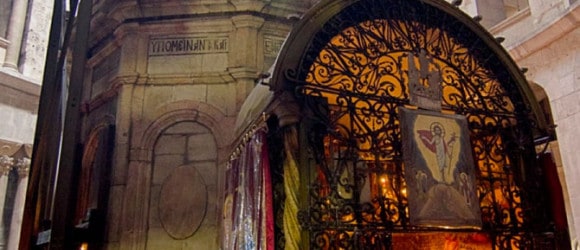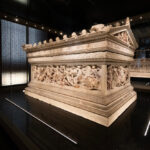The Mausoleum of Jesus
- At August 24, 2013
- By mausoleum
- In Doug Keister's Blog
 0
0

Travelers to the Holy Land will soon find out that there are two places that purport to be the burial place of Jesus. The most famous and well known site is in the Church of the Holy Sepulchre, within the city walls of Old Jerusalem.
The first Church of the Holy Sepulchre was built in the fourth century under orders from the Emperor Constantine. The work was actually supervised by Constantine’s mother, Helena. The story goes that, during Helena’s time there, both Golgotha, the Hill of Calvary, and Jesus’ rock-cut tomb were found in the same area and both were incorporated into the greater church building. The area around the rock-cut tomb is said to have been chipped away, but the tomb itself preserved.
Like much of the history in the Holy Land, specific events have become clouded over time. The original church building was destroyed and, as the centuries ticked on, various parts of subsequent churches were damaged, built, and rebuilt numerous times by various political and religious factions that occupied Jerusalem. Perhaps the most notable episode in the long history of the church is when the Crusaders retook the church from the Fatimids during the First Crusade in 1099.
Fire destroyed much of the main church building in 1808, and it was rebuilt in the Ottoman Baroque style. That building is one of many of an amalgam of interconnected structures in what amounts to an architectural smorgasbord.
Inside the church, and centered under the dome built in 1870, is a structure known as The Aedicule (little chapel). It also known as the Edicule and is said to have been built around the remains of the rock-cut tomb of Jesus. The Aedicule is technically a mausoleum. It contains two rooms, a chapel-like antechamber and Jesus’ burial chamber that is accessed through a low doorway.
The original Aedicule site dates to Constantine’s time. In the middle of the sixteenth century, Franciscan friars extended it and built the antechamber. The fire in 1808 destroyed much of the exterior marble work of The Aedicule although the footprint of the structure has remained largely intact. The ownership of The Aedicule has always been a matter of considerable dispute between various religious factions. Those factions have formed what amounts to a co-ownership agreement. The fragile and deteriorating Aedicule has been bolstered by scaffolding since 1947 since an agreement has not been reached on what entity should restore it.
Entry into and photographing in the tight space of the Aedicule is no easy task, but I was able to obtain access in late 2011. Here’s a video too.
Text and copy © Douglas Keister Visit Doug’s Author Page
